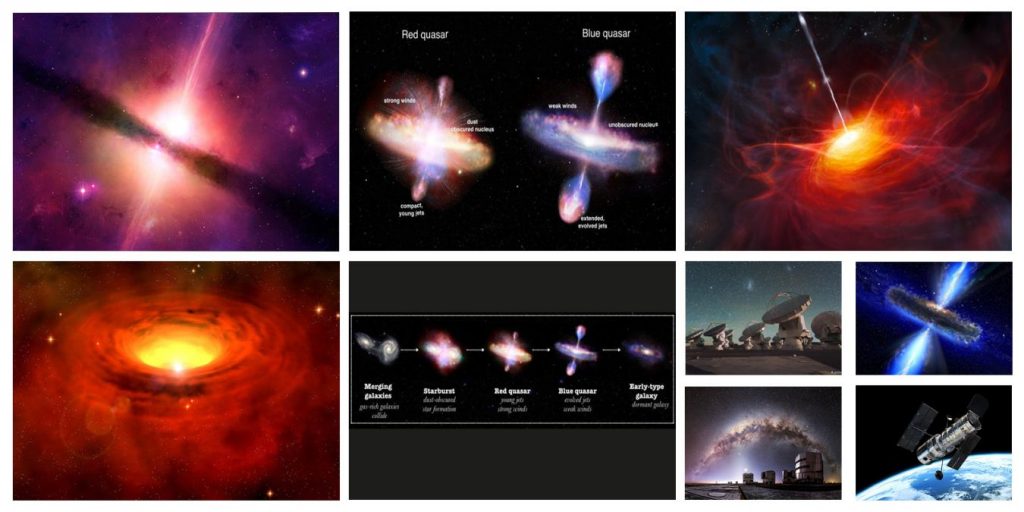
This energy exceeds the total of the light of all the stars within a galaxy. The subaru (left), the Submillimeter Array (top right), and the Chandra X-ray Observatory images of the monster galaxy hosting a protoquasar. Quasars emit energies of millions, billions, or even trillions of electron volts. Until now, objects like GNz7q have only been. This object will offer a special ‘laboratory’ for astronomers to investigate how super-massive black holes are growing up. Supermassive black holes are believed to come into being as embryos in the cores of dusty starburst galaxies, eventually getting rid of all that dust and gas when they crawl out as quasars, ultraluminous active galactic nuclei (AGNs) so bright that they can easily outshine all the stars in a galaxy. Surprisingly, the total amount of energy emitted by the X-ray object reaches two trillion times of that from the Sun, and the only phenomenon which can naturally explain the origin of the energy is a rapid growth of a massive black hole at the heart of the monster galaxy. Luminous high-redshift quasars are thought to be hosted by the most mas- sive and luminous galaxies in the early. In contrast, the heart of the galaxy is unseen in visible light, likely because the monster galaxy is completely enshrouded by a dark nebula. All observed spectra have shown considerable redshifts, ranging from 0.06 to the recent maximum of 6.4. These are visible in many parts of the electromagnetic spectrum, including radio, infrared, optical, ultraviolet, X-ray, and even gamma rays. Supermassive black holes change the central regions of galaxies. They found compelling evidence for the existence of a proto-quasar from their observations in the submillimeter-wave and X-ray, which penetrate even thick gas clouds. Quasars exhibit many of the same properties as active galaxies. 5 A luminosity distance of D L 749 megaparsecs (2.4 gigalight-years) may be calculated from z. It is the optically brightest quasar in the sky from Earth ( m 12.9), and one of the closest with a redshift, z, of 0.158. It was the first quasar ever to be identified.

to investigate a monster galaxy that the team already found in a overcrowded region of galaxies, where galaxy collisions are expected to occur very often. 3C 273 is a quasar located in the constellation of Virgo. Since then, they have found many more examples of quasar-galaxy gravitational lenses, allowing researchers to calculate the masses of the foreground galaxies. The team used several telescopes including a submillimeter telescope ASTE, the Subaru telescope, and the Submillimeter Array in the U.S. But proto-quasars are expected to be covered by a dark cocoon of dust and gas, which could be troublesome for astronomers to observationally confirm their existence. The important step to test this hypothesis is to find observational signatures of a baby quasar, called a “proto-quasar”. There is a longstanding prediction that quasars form when galaxies clash into each other, which can feed a huge amount of gaseous fuel to the central black holes. Quasars are the most luminous nuclei of galaxies in the Universe, and are believed to be powered by gravitational energy of super-massive black holes residing at the centers of galaxies. In a spectrum of a distant galaxy, these same lines are observed to have wavelengths of 492 nm, 521 nm, 583 nm, and 787 nm respectively.Nobeyama Astronomers Find a Proto-quasar - a Young Super-massive Black Hole - in a Dark Monster GalaxyĪn international team led by astronomers at the NAOJ Nobeyama has discovered a candidate for a proto-quasar 11.5 billion light-years away from the Earth.

Several lines of hydrogen absorption in the visible spectrum have rest wavelengths of 410 nm, 434 nm, 486 nm, and 656 nm.

galaxy) we see emission lines in the spectrum of the quasar 3C 273. The quasar is thus receding from us at about 95% the speed of light. The luminosity of a normal galaxy does not change much over short periods of time.


 0 kommentar(er)
0 kommentar(er)
